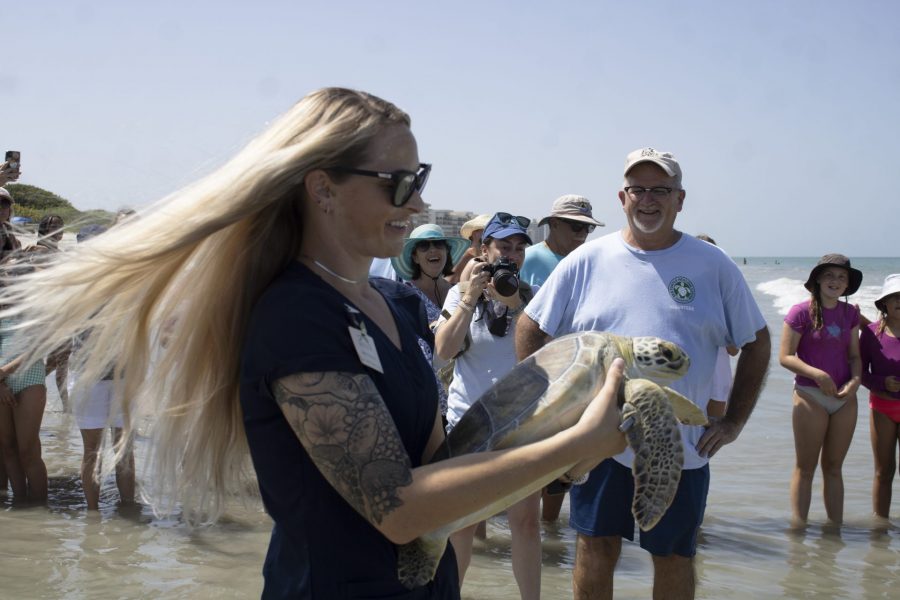

Quite the crowd gathered to wish Venus well!
After nearly two years of care from our Sea Turtle Healing Center, green sea turtle Venus went home to the ocean on World Sea Turtle Day on June 16, 2022.

This photo was taken of Venus the day he was brought to our Sea Turtle Healing Center.
When Venus first came to us in July 2020, we weren’t sure this day would come. Members of the East Coast Biologists had found Venus entangled in fishing line. The entanglement around his front flippers was so severe, the line had cut through the skin and bone, affecting the integrity of his bones.
Our team started a number of treatments to keep the area clean and the blood flowing to his flippers: antibiotics, laser therapy, honey therapy, flipper massages and even leech therapy. It took time for Venus to get most of the range of motion in his front flippers.
Despite his traumatic injury, Venus was active, curious – and hungry – from the start of his recovery. He enjoyed nearly all the enrichment items given to him by our Healing Center staff and had several roommates over the years.
Once Venus’ flippers had stabilized, our Healing Center team started looking into determining whether he could be released.

These x-ray images show the fractures in Venus’ front flippers.
We take the possibility of a sea turtle patient being nonreleasable very seriously, and only make this call if a turtle might be unable to deal with the hazards of ocean life or might be unable to act on their natural behaviors. We were concerned that Venus might not be able to outrun or dive from predators or boats, deal with rough ocean conditions or nest properly if they were female.
Venus was sent to the Florida Aquarium’s Sea Turtle Rehabilitation Center for a deep-water trial with his roommate McNubbins. In this test, the two turtles are given access to an 11-foot-deep pool. Staff at the aquarium write detailed logs on how each turtle swims. This gives our care team more insight into how a sea turtle would handle being in the ocean. If they can’t dive quickly, this might mean that they are vulnerable to boats or predators. Venus did well during his test!
Our care team decided that learning Venus’ sex would give us even more insight into how he would fare in their natural range. Female sea turtles use their front flippers to pull themselves onto the beach to build their nest and lay eggs. The severity of his injuries might make this natural behavior impossible for Venus if he was female.
Although we are using male pronouns in this post, we used “they” Venus at the start – as we do for most sea turtle patients. We rarely find out a sea turtle’s sex! Sea turtle genitalia is internal, so the only way to learn a sea turtle’s sex is through an invasive endoscope procedure. We only undertake this if it’s medically necessary. For Venus, we knew this information was crucial as we considered his release. Through this procedure, we discovered that Venus is male.
With all the information we compiled, we decided to move forward with Venus’ release! On World Sea Turtle Day, a crowd gathered at Howard E. Futch Memorial Park at Paradise Beach to wish Venus and another juvenile green sea turtle, Reptar, well as they went back to the ocean. Bon voyage, Venus!
Have you found a sea turtle that needs help? Visit this page or call the Sea Turtle Preservation Society at 321-206-0646.
Want to help the Sea Turtle Healing Center? Support our Zoo, or view our Healing Center’s wishlist.
